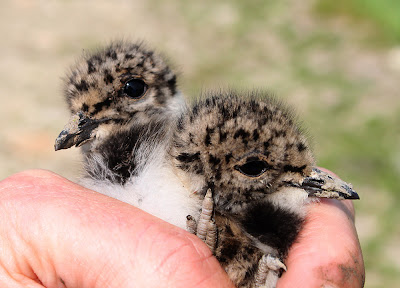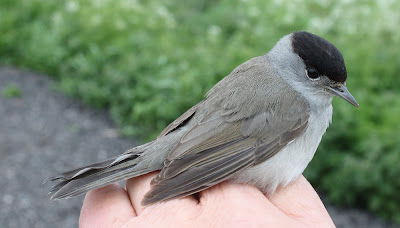Quiet again today although I did find another brood of two Lapwing chicks to ring at Pilling. That's at least 8 pairs bred successfully this year. The ground is very dry at the moment which explains the dried mud on their tiny bills.
Lapwing chicks
Finally, here are the Hoopoes pictures promised from the recent Menorca holiday.
The Hoopoe Upupa epops is found across Afro-Eurasia and is a bird noted for its distinctive crown of feathers. The Latin name Upupa epops is an onomatopoetic form which imitates the call of the bird, a trisyllabic "oop-oop-oop".
Hoopoe
Hoopoes are fairly common in Menorca, although the species is quite shy, with a brief flight view or just the call the best indication one is around. They are not normally as tolerant to being observed as a pair I found near on the coast near the little town of Es Migjorn, Menorca during my recent holiday in early May. I would see one bird most days, either feeding itself or sometimes flying off with large food items, a sign that the bird was probably a male carrying food to a sitting female. Hoopoes nest in holes, normally trees or walls, so I hoped that soon I might find where the bird flew to.
Hoopoe
The diet of the Hoopoe is mostly composed of insects, although small reptiles and frogs as well as some plant matter such as seeds and berries are sometimes taken as well. It is a solitary forager which typically feeds on the ground. Common diet items include crickets, locusts, beetles, earwigs, cicadas, ant lions, bugs and ants.
In the second week the same feeding bird seemed to switch to carrying off just small items of food, some of which it gleaned by searching the crevices of palm trees. By now I was fairly sure it was feeding tiny young and the female might also be more active, although as both sexes look the same I couldn’t be sure if I was watching one or two birds, although the crown feathers of the regular bird were well worn.
Hoopoe
Day 12 saw both bird birds feeding close together when I was able to distinguish the male and the female separately. The female had an almost unblemished, unworn crest. When I found the nest hole I could see that the male’s constant toing and froing at the hard concrete nest hole had probably worn his crest feathers, with the less active female able to retain her crown feathering.
Hoopoe Nest Site
Hoopoe
From the car I watched and photographed the birds around the nest site and their by now heavy feeding routine. At times the female stayed with the youngsters while the male passed food through the nest hole. In one of the pictures below the female’s bill can be seen accepting food from the male. At other times she appeared to show aggression towards her partner.
Hoopoe
Hoopoe
Hoopoe
Food Pass
Female Hoopoe
Female Hoopoe
Hoopoes
What a privilege to be able to see the Hoopoe’s breeding behaviour close to but what a shame I wasn’t there to see the young emerge from the nest.
If ever you are in Menorca, Es Migjorn is a typical friendly small town with a number of good bars and cafes. You may bump into Paco who takes wonderful photographs of the Menorcan landscape, much better than mine. Take a look on his blog by clicking on "Paco" above.
Es Migjorn
Es Migjorn
To Es Migorn



































































.jpg)














